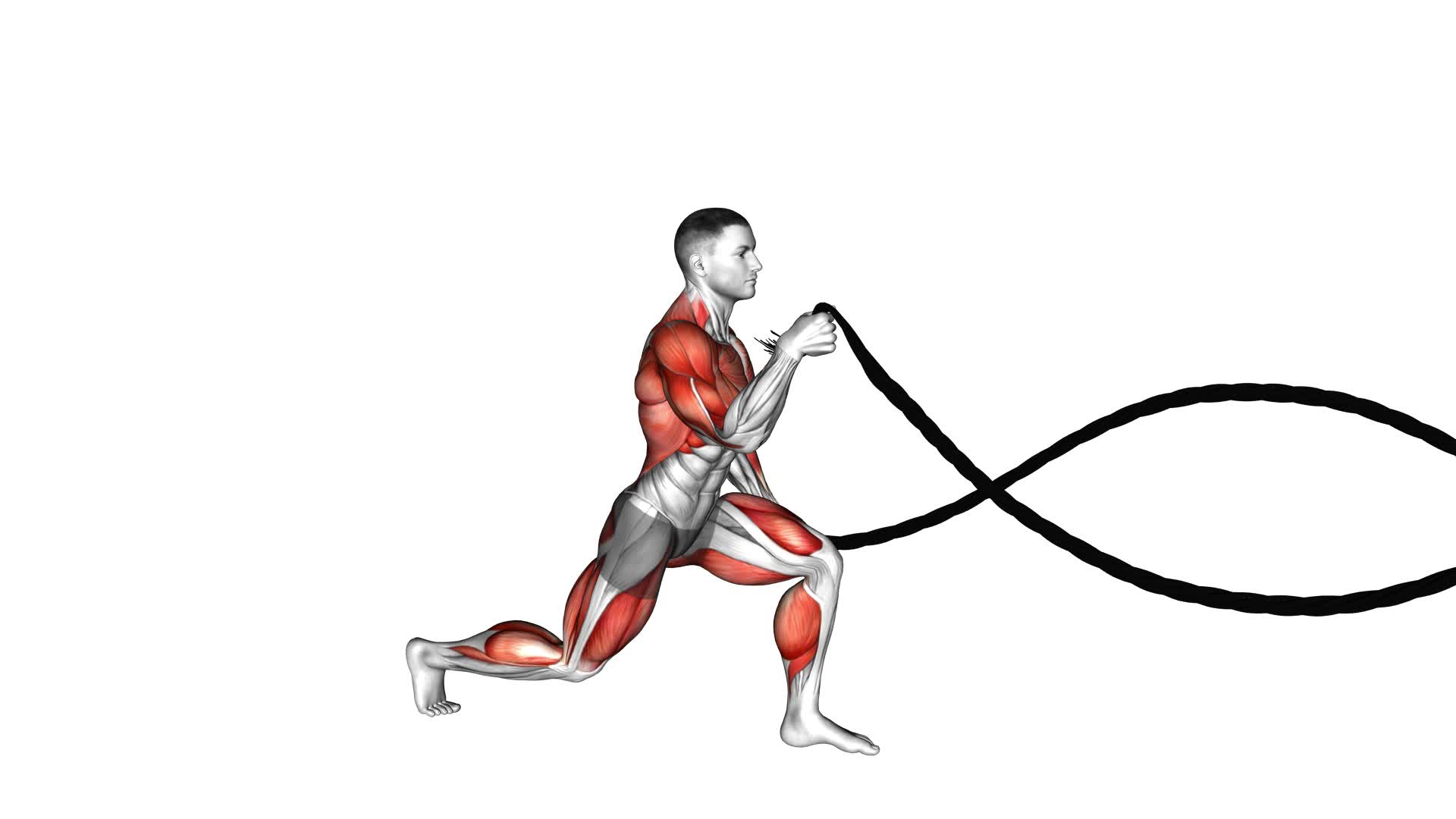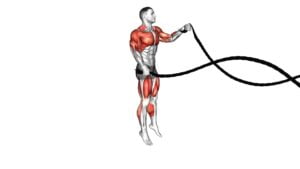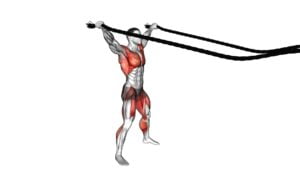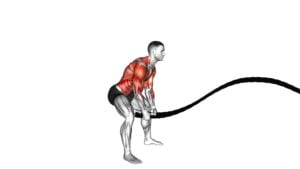Battling Ropes Split Jump – Video Exercise Guide & Tips

Are you looking for a dynamic way to challenge your body and boost your fitness level? Look no further than the Battling Ropes Split Jump.
Watch This Exercise Video
This intense exercise targets multiple muscle groups and improves both strength and agility. In this video exercise guide, you'll learn the proper technique and body positioning to maximize your results.
Whether you're a beginner or a seasoned athlete, this exercise offers modifications and progressions to suit your fitness level.
Get ready to take your workouts to the next level with this powerful move.
Key Takeaways
- Proper body positioning and technique are essential for performing the Battling Ropes Split Jump effectively.
- The split jump targets the quadriceps, hamstrings, glutes, and calves, resulting in stronger and more toned lower body muscles.
- Variations such as depth jump split jumps and weighted split jumps can challenge the muscles further and add plyometric training.
- It is important to seek professional guidance, warm up properly, and consult with healthcare professionals before starting the split jump or any new exercise routine to ensure safety and effectiveness.
Proper Body Positioning
Position your body correctly for the Battling Ropes Split Jump exercise. Proper body positioning is crucial for maximizing the benefits of this exercise and improving your balance and stability.
Firstly, maintaining a strong and stable core is essential. Engage your abdominal muscles and keep your spine in a neutral position throughout the exercise. This will help you maintain proper alignment and prevent strain on your lower back.
Secondly, focus on your lower body positioning. Keep your feet shoulder-width apart and make sure your knees are aligned with your toes. This will ensure proper alignment and help prevent knee injuries.
To improve balance and stability during split jumps, it's important to distribute your weight evenly between both legs. This will help you stay grounded and prevent any wobbling or loss of control.
Additionally, keep your chest lifted and your shoulders relaxed. This will help maintain proper posture and prevent any unnecessary strain on your upper body.
By positioning your body correctly during split jumps, you can experience the benefits of improved balance, stability, and overall lower body strength.
Split Jump Technique
To properly execute the Battling Ropes Split Jump exercise, it's important to master the technique and perform it with confidence and control. The split jump is a plyometric exercise that targets the lower body muscles, including the quadriceps, hamstrings, glutes, and calves. It also helps to improve explosive power, coordination, and balance.
To perform the split jump, start in a lunge position with one foot forward and the other foot behind you. Lower your body into a deep lunge, keeping your front knee aligned with your ankle. From this position, explosively jump up and switch your feet in mid-air, landing with the opposite foot forward. Be sure to land softly and maintain a controlled landing to minimize the impact on your joints.
As you become more comfortable with the split jump, you can incorporate variations such as adding weights or increasing the height of your jump. Remember to always warm up properly before attempting the split jump and listen to your body to avoid injury.
Targeted Muscle Groups
The split jump exercise targets multiple muscle groups in the lower body, helping to strengthen and tone the quadriceps, hamstrings, glutes, and calves. By incorporating this exercise into your workout routine, you can experience a range of benefits from targeted muscle group training.
Here are some of the benefits of targeted muscle group training:
- Increased strength: By focusing on specific muscle groups, you can effectively increase their strength and power. The split jump specifically targets the lower body muscles, helping you to build strong and powerful legs.
- Improved muscle definition: Targeted muscle group training can help to improve the definition and tone of specific muscles. The split jump engages the quadriceps, hamstrings, glutes, and calves, helping you to achieve a more sculpted lower body.
- Enhanced athletic performance: By strengthening the muscles involved in jumping and explosive movements, the split jump exercise can improve your athletic performance. It can help you jump higher, run faster, and move more efficiently.
- Injury prevention: Strengthening specific muscle groups can help to prevent injuries by improving stability and balance. The split jump targets the lower body muscles, which are essential for movements such as running, jumping, and landing.
Incorporating effective exercises for muscle group isolation, like the split jump, into your workout routine can help you achieve your fitness goals and improve overall strength and muscle tone.
Modifications and Progressions
To modify and progress the split jump exercise, you can incorporate variations that challenge your lower body muscles and increase the intensity of the movement. These modifications and variations can help you continue to challenge yourself as you become stronger and more proficient in the exercise.
One modification you can try is the depth jump split jump. Instead of starting from a standing position, you begin by stepping off a platform or box and immediately performing a split jump upon landing. This increases the demand on your lower body muscles and adds an element of plyometric training to the exercise.
Another modification is the weighted split jump. By holding dumbbells or a kettlebell in each hand, you add resistance to the movement and further engage your muscles. Start with lighter weights and gradually increase the load as you become more comfortable and confident.
To progress the split jump exercise, you can try the single-leg split jump. Instead of jumping from a split stance, you jump from a single leg, alternating between legs with each repetition. This variation increases the challenge on your balance and stability, as well as your lower body strength.
Incorporating these modifications and variations into your split jump routine can help you continually challenge your muscles and improve your overall performance. Remember to always prioritize proper form and technique to minimize the risk of injury and maximize the benefits of the exercise.
Safety Tips and Common Mistakes
Avoiding common mistakes and ensuring safety is crucial when performing the split jump exercise using battling ropes. To prevent common injuries and make the most out of your workout, follow these safety tips and incorporate warm-up exercises:
- Use proper form: Maintain a strong core, engage your glutes, and keep your knees aligned with your toes during the split jump. This will help prevent strain on your joints and reduce the risk of injury.
- Start with a warm-up: Before attempting the split jump, warm up your body with dynamic stretches and light cardio exercises. This will increase blood flow to your muscles and prepare them for the intense workout.
- Avoid overexertion: Listen to your body and avoid pushing yourself too hard. Gradually increase the intensity and duration of your split jump workouts to prevent overuse injuries.
- Seek professional guidance: If you're new to split jumps or battling ropes, consider working with a certified trainer who can guide you through proper form and technique. They can also provide modifications based on your fitness level and any pre-existing conditions.
By following these safety tips and incorporating warm-up exercises, you can minimize the risk of common injuries and maximize the effectiveness of your split jump workouts.
Always prioritize safety and consult with a healthcare professional before starting any new exercise routine.
Frequently Asked Questions
How Long Should I Rest Between Sets When Performing Split Jumps With Battling Ropes?
When performing split jumps with battling ropes, it's important to give yourself enough rest between sets. This allows your muscles to recover and prevents overexertion.
The proper rest duration can vary depending on your fitness level and intensity of the exercise. However, a good starting point is to rest for about 30-60 seconds between sets.
Remember to also focus on maintaining proper form throughout the exercise to avoid injury and maximize results.
Can Split Jumps With Battling Ropes Help Improve My Vertical Jump?
Split jumps with battling ropes can definitely help improve your vertical jump. By incorporating battling ropes into your split jumps, you add resistance and challenge your muscles to work harder. This can lead to increased explosiveness and power in your jumps.
Additionally, there are various variations of split jumps that you can try with battling ropes, such as alternating legs or adding a jump at the end. These variations can further enhance your vertical jump and overall athletic performance.
Are Split Jumps With Battling Ropes Suitable for Beginners?
Split jumps with battling ropes can be suitable for beginners with a few modifications. Start by using lighter ropes or shorter lengths to reduce the intensity. Focus on proper form and technique, landing softly with bent knees to avoid strain.
Common mistakes to avoid include jumping too high, which can lead to injury, and neglecting to engage the core and upper body.
With practice, split jumps with battling ropes can help build strength, endurance, and improve your vertical jump.
Can Split Jumps With Battling Ropes Help With Weight Loss?
Split jumps with battling ropes can be a great addition to your weight loss journey. Not only do they help with overall fitness, but they also provide a high-intensity workout that burns calories and builds strength.
By incorporating split jumps with battling ropes into a HIIT workout routine, you can maximize the benefits and see faster results.
How Many Reps Should I Aim for When Performing Split Jumps With Battling Ropes?
When performing split jumps with battling ropes, it's important to consider your fitness level and goals. Start with a lower number of reps, like 8-10, and gradually increase as you build strength and endurance.
Beginners can modify by using lighter ropes or performing split jumps without the ropes at first. There are also different variations of split jumps with battling ropes, such as alternating legs or adding a squat before jumping.
Remember to listen to your body and adjust accordingly.
Conclusion
In conclusion, the split jump is an effective exercise for improving lower body strength and power. By following proper technique and positioning, you can target your quadriceps, glutes, and calves.
It's important to start with modifications and gradually progress to more challenging variations to avoid injury. Remember to always prioritize safety and be mindful of common mistakes.
Incorporating the split jump into your routine can help you achieve your fitness goals and enhance overall athleticism.

Author
Years ago, the spark of my life’s passion ignited in my mind the moment I stepped into the local gym for the first time. The inaugural bead of perspiration, the initial endeavor, the very first surge of endorphins, and a sense of pride that washed over me post-workout marked the beginning of my deep-seated interest in strength sports, fitness, and sports nutrition. This very curiosity blossomed rapidly into a profound fascination, propelling me to earn a Master’s degree in Physical Education from the Academy of Physical Education in Krakow, followed by a Sports Manager diploma from the Jagiellonian University. My journey of growth led me to gain more specialized qualifications, such as being a certified personal trainer with a focus on sports dietetics, a lifeguard, and an instructor for wellness and corrective gymnastics. Theoretical knowledge paired seamlessly with practical experience, reinforcing my belief that the transformation of individuals under my guidance was also a reflection of my personal growth. This belief holds true even today. Each day, I strive to push the boundaries and explore new realms. These realms gently elevate me to greater heights. The unique combination of passion for my field and the continuous quest for growth fuels my drive to break new ground.







